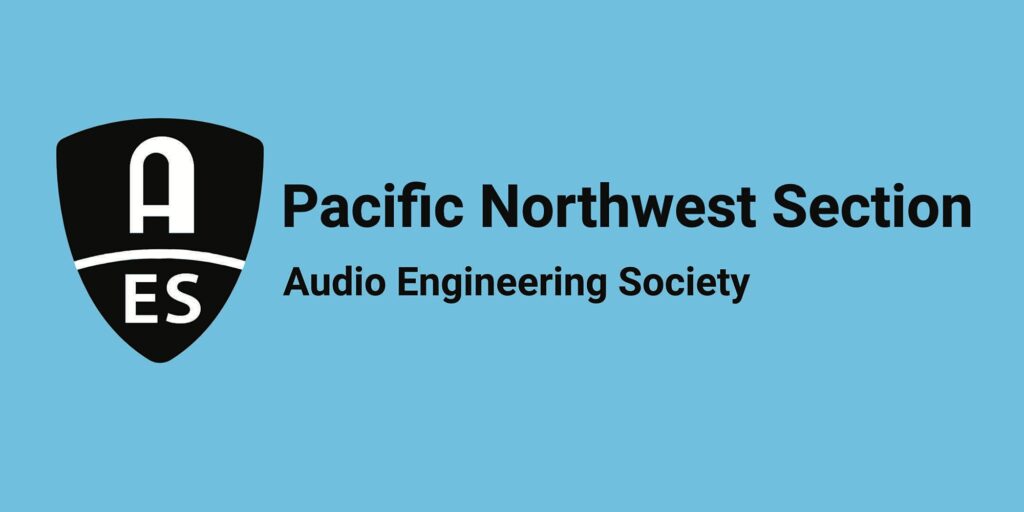
Reality is Boring: Expressing Feelings/Movements via Impressionistic Foley
May 6, 2022 @ 6:00 pm - 10:30 pm
ZOOM MEETING 6:00PM PDT (UTC -7)
Friday, May 6, 2022
Presented by
Joanna Fang
and
The Pacific Northwest Section of the Audio Engineering Society
Note that this meeting starts at 6:00pm Pacific Daylight Time, which is UTC -7. There are many countries in the world where that is the middle of normal sleep time, so if you intend to sleep normally that day you may want to watch the video when it comes out rather than signing up here and not showing up.
That said, it’s free to sign up, so do whatever makes you happy.
This will be a Zoom meeting.
Presentation Description:
In filmmaking, Foley is the reproduction of everyday sound effects that are added to films, videos, and other media in post-production to enhance audio quality. These reproduced sounds, named after sound-effects artist Jack Donovan Foley, can be anything from the swishing of clothing and footsteps to squeaky doors and breaking glass. Foley sounds are used to enhance the auditory experience of the movie. Foley can also be used to cover up unwanted sounds captured on the set of a movie during filming, such as overflying airplanes or passing traffic.
Places where the Foley process takes place are often referred to as a Foley stage or Foley studio. Foley artists recreate the realistic ambient sounds that the film portrays. The props and sets of a film often do not react the same way acoustically as their real life counterparts, requiring filmmakers to Foley the sounds. The best Foley art is so well integrated into a film that it goes unnoticed by the audience. It helps to create a sense of reality within a scene. Without these crucial background noises, movies feel unnaturally quiet and uncomfortable.
The Wikipedia page about Foley
Some questions about Foley:
How do we craft sound effects for a warm embrace, a desperate walk, or a fluttering heart?
Filmmakers, game developers, and musicians often try to render meaningful and empathetic performances through sound design and Foley. But what is the implication for Foley artists in a world that’s exponentially recorded and archived? Where is the line between “cheating” a sound for an audience’s emotional response, and achieving forensically accurate sound reproduction in increasingly augmented or fully virtual productions?
Joanna will address these and other issues in her presentation.
Additional information can be found at
Pacific Northwest Section of the Audio Engineering Society Website.
Go here to get on our emailing list.
THIS EVENT IS FREE, OPEN TO ALL, AND AES MEMBERSHIP IS NOT REQUIRED

About The Presenter
Joanna Fang is an Emmy Award winning Foley artist and sound editor. An alumna of NYU Film, Joanna spent the first 12 years of her career performing custom Foley and sound effects for film and TV in New York with Alchemy Post Sound.
Having transitioned into interactive work, Joanna was recently brought on to co-lead and develop Sony Playstation’s in-house Foley team.
Her Foley can be heard in films (The Texas Chainsaw Massacre), games (Horizon Forbidden West), and music videos (Mitski’s Working for the Knife).
Alchemy Post Sound
Joanna’s Facebook Page (must log in to Facebook to see)
PNW AES Zoom Meetings
We started holding our meetings via Zoom beginning with the April 2020 meeting. Zoom has dramatically increased our reach, well beyond our Section’s geographic area. Since doing this, we’ve regularly had attendees from:
-most Provinces in Canada;
– most countries in:
–Europe,
–Central and South America;
-Japan,
-India,
-Indonesia,
-Malaysia,
-Australia,
-and more. It’s been unbelievable how many cool audio people we’ve met.
Zoom gives the ability to record videos of our meetings, and those recordings are individually posted in our past meetings Archive. For now, the collected videos from our Zoom meetings can be found (mostly) at Dan Mortensen’s DansoundSeattle YouTube channel.
We use EventBrite to manage our free tickets to meetings. You are in the right place to RSVP for your ticket for this event.
The Zoom URL and physical meeting location (if this is a hybrid meeting) will be sent in three reminders: two days, the morning of, and two hours before the event starts.
When you register at EventBrite and when you enter the Zoom meeting, please use your real first and last names so we can get to know each other. You do NOT need to create an EventBrite account to register.
Please Note
In order to maintain decorum and avoid interruptions, even unintended ones, we have established a few ground rules for meeting attendees:
1. We want to see your full name on display in Zoom at the meeting.
2. The presenter(s) will determine if they can accept questions during the presentation, or wait until specific Q&A times, and that will be announced at the beginning of the meeting. (We often use the “chat” feature to allow attendees to ask questions when they think of them, with moderators passing them on to the presenter at the appropriate time.)
3. Please mute your microphone when not talking (a moderator may mute you if you haven’t muted yourself; if they do, Zoom won’t let you un-mute until a moderator clears you again.)
4. Based on our experience with no-shows, we reserve the right to issue more tickets than available slots. We don’t want to turn people away based on inaccurate estimates of attendance, but we do have budgetary limits to the number of slots we can make available. If we reach capacity before you log in, we regret that we may have no way to expand capacity at the last minute.
5. Some presenters are distracted when confronted by a sea of video faces or other images, so for some meetings we may ask that you turn your camera/images off during the presentation. If you forget, one of our moderators may do it for you, and you may or may not get a private chat note informing you.
6. During the meeting, there is the matter of your camera. We’re going to leave that up to the presenter; whether they want to see their audience while they present or not. If they want to see who they’re talking to, then you can leave your camera live or not, as you prefer, however if the presenter doesn’t want to see the audience, then we’ll ask you to turn your video off.
7. Moderators have the ability to globally turn everyone’s video off, however turning it back on is troublesome; we are forced to turn cameras back on manually, one by one. There is no way for you to override that. You’ll need your camera live later in the meeting for the self-introductions.
8. Best is that if we ask for cameras to be on or off, that you do this individually on your own.
9. It would be good if you watched the chat stream during the meeting. Not only is it a way to submit questions to the presenters, but it’s also a way for others to contact you personally. You have the option there to direct your comment to anyone who is part of the meeting as well as to one person in particular.
Finally, in the rare instance of behavior by an attendee that moderators believe is disruptive, we reserve the right to immediately eject such attendees.
